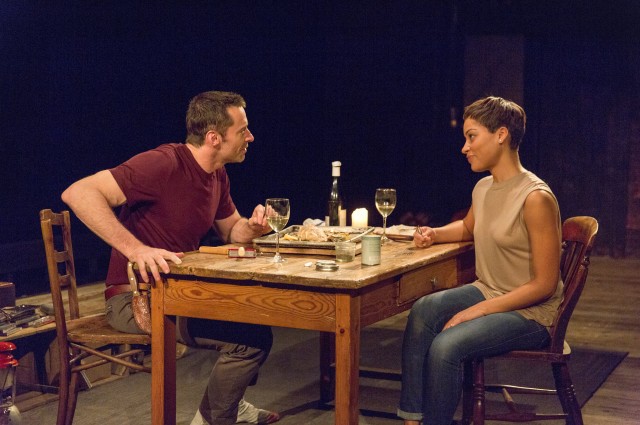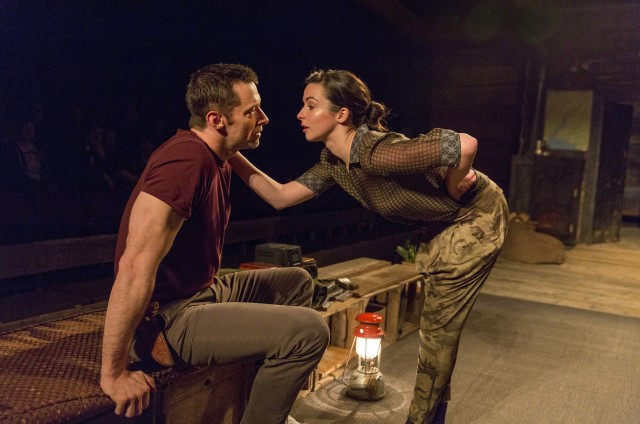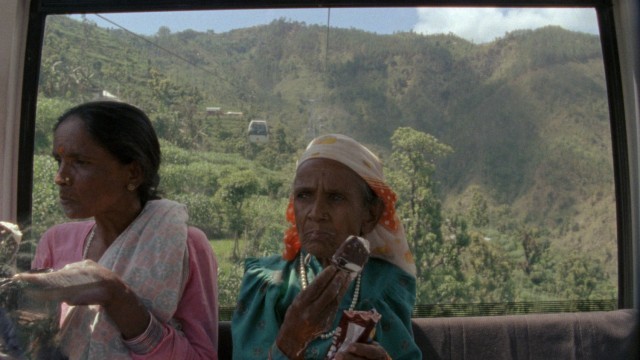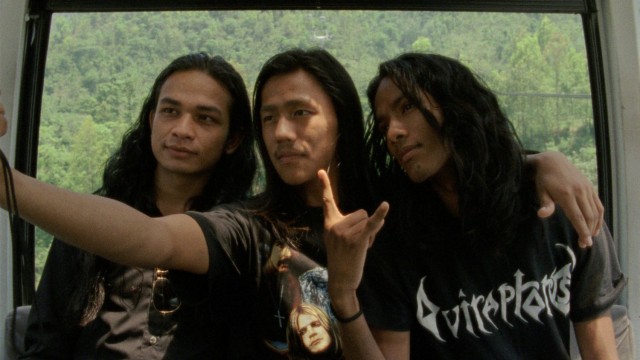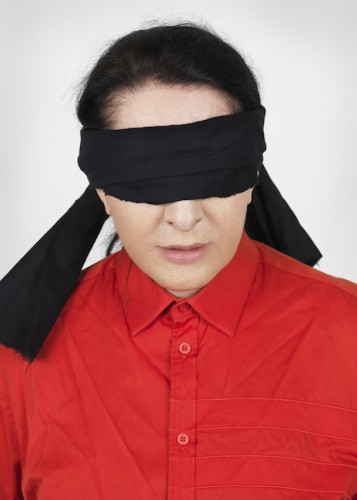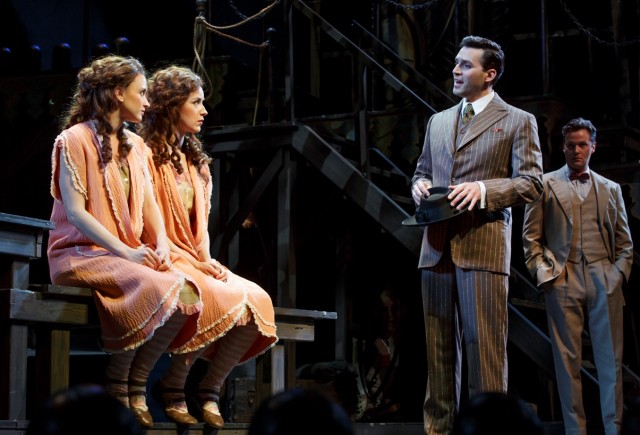
Terry Connor (Ryan Silverman) and Buddy Foster (Matthew Hydzik) try to convince conjoined twins Daisy (Emily Padgett) and Violet (Erin Davie) to leave their Texas freak show for vaudeville stardom in SIDE SHOW (photo by Joan Marcus)
St. James Theatre
246 West 44th St. between Broadway & Eighth Aves.
Tuesday – Sunday through January 4, $49 – $145
www.sideshowbroadway.com
Oscar-winning writer-director Bill Condon makes a rousing Broadway debut with Side Show, a wonderful revival of the Tony-nominated 1997 musical about real-life conjoined twins Daisy and Violet Hilton. In Depression-era Texas, the daring, outgoing Daisy (Emily Padgett) and the shy, reserved Violet (Erin Davie) are the stars of a freak show run by a controlling ringmaster they call Sir (Robert Joy), who considers them his daughters while also overseeing the rest of his wild menagerie, which includes the 3 Legged Man (Brandon Bieber), the Geek (Matthew Patrick Davis), Venus di Milo (Lauren Elder), Dog Boy (Javier Ignacio), Reptile Man (Don Richard), the Half Man/ Half Woman (Kelvin Moon Loh), the Bearded Lady (Blair Ross), the Fortune Teller (Charity Angel Dawson), and the small Cossack Male (Josh Walker) and Cossack Woman (Jordanna James). When talent agent Terry Connor (Ryan Silverman) sees the twins, who are joined at the hip, he instantly visualizes them becoming stars on the vaudeville circuit. He has his partner, Buddy Foster (Matthew Hydzik), teach them song-and-dance routines, but when they’re at last ready and willing to leave the side show, the dastardly Sir stands in their way, and a thrilling tabloid-tale court battle ensues, also involving Sir’s right-hand man, Jake (David St. Louis), who serves as the twins’ protector. After the court’s decision, Buddy is soon falling for Violet, who Jake also deeply admires, while Daisy sets her sights on Terry. The romantic pentagon comes to a climax at an extravagant New Year’s Eve celebration that has the talented twins wondering if they might just be better off living separately, risking all on a potentially deadly operation.
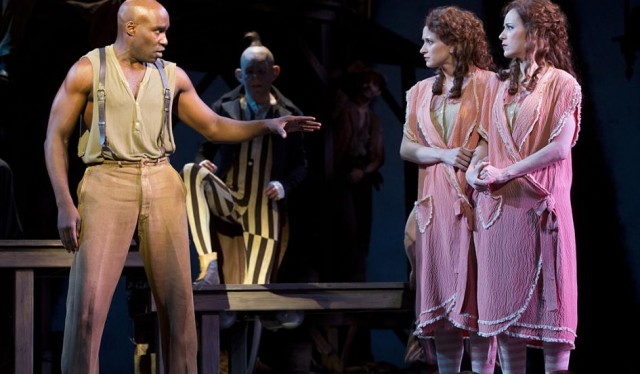
Jake (David St. Louis) tells Daisy (Emily Padgett) and Violet (Erin Davie) that the devil they know might be better than the devil they don’t in stirring revival (photo by Joan Marcus)
Padgett (Rock of Ages, Legally Blonde) and Davie (Grey Gardens, The Mystery of Edwin Drood) are terrific as Daisy and Violet, respectively, beautifully displaying the characters’ emotional hopes and fears as a new world opens up to them that threatens their unique relationship. Joy (The Nerd, Hay Fever) is deliciously dastardly as Sir, while Silverman (Passion) and Hydzik (West Side Story) make a fine duo, the former full of smooth-talking charm, the latter sweet melancholy. St. Louis (Rent, Jesus Christ Superstar) brings down the house early on with a powerful rendition of “The Devil You Know” that shakes the rafters. Bill Russell’s lyrics and Henry Krieger’s (Dreamgirls, The Tap Dance Kid) music flow nearly imperceptibly from the exemplary book, which was written by Russell with new material by Condon, wisely never overdoing the idea that’s it’s okay to be different. The score, which contains additions and subtractions from the original production, features such moving numbers as “Cut Them Apart / I Will Never Leave You,” “Stuck with You / Leave Me Alone,” and the gorgeous “Who Will Love Me as I Am?” while such words as “connected,” “ties,” “bind,” “join,” “glue,” etc., become sly nods to the conjoined-twins aspect of the tale. David Rockwell’s eye-catching set has a sweet Gothic touch, while Paul Tazewell’s costumes, from the Hilton sisters’ gowns to the freaks’ general appearance, are simply fab. Condon and choreographer Anthony Van Laast do a marvelous job of keeping the twins together through most of the show, except for one breathtaking, memorable moment. If you want to find out more about the Hilton sisters after seeing the show, seek out Leslie Zemeckis’s 2012 documentary, Bound by Flesh, which includes plenty of archival photographs and film footage.
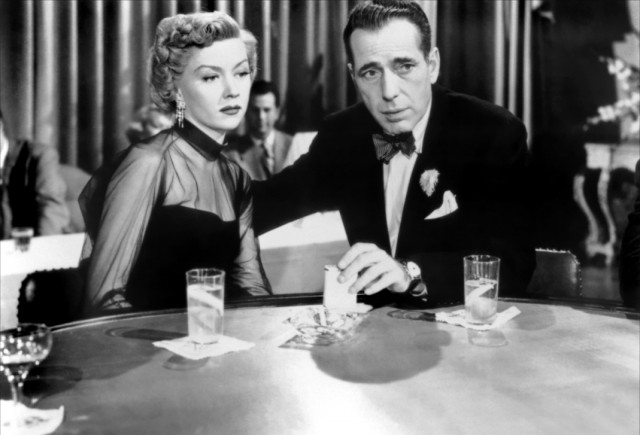
 Humphrey Bogart stars in Nicholas Ray’s powerful, intense film about a cynical Hollywood screenwriter with a violent side. Dixon Steele (Bogart, in one of his strongest performances) is asked to write a screenplay based on a pulpy romance he has little interest in, so he brings home a coat-check girl (Martha Stewart) who has read the book so she can tell him the story. The girl turns up dead, and Steele, known for his drunken forays and abuse of women, is the main suspect. Aspiring star Laurel Gray (Gloria Grahame), who has recently moved into the same Beverly Hills apartment complex, supplies an alibi for Steele, but she might have ulterior motives for doing so. Ray’s moody, introspective gem keeps you guessing until the very end. Ray (They Live by Night, Rebel Without a Cause) was briefly married to Grahame (The Bad and the Beautiful, Oklahoma!); they divorced when she had an affair with Ray’s teenage son, whom she later wed and had two children with. In a Lonely Place is screening November 29 at 2:00 & 7:00 as part of the BAMcinématek series “Sunshine Noir,” a two-week festival being held in conjunction with the Next Wave Festival presentation of Gabriel Kahane’s The Ambassador, a visual and musical exploration of Los Angeles, directed by John Tiffany. The film series runs November 26 – December 9 and includes such other L.A.-set works as Roman Polanski’s Chinatown, Brian De Palma’s Body Double, Steven Soderbergh’s The Limey, Joseph Losey’s remake of M, and Robert Mulligan’s The Nickel Ride.
Humphrey Bogart stars in Nicholas Ray’s powerful, intense film about a cynical Hollywood screenwriter with a violent side. Dixon Steele (Bogart, in one of his strongest performances) is asked to write a screenplay based on a pulpy romance he has little interest in, so he brings home a coat-check girl (Martha Stewart) who has read the book so she can tell him the story. The girl turns up dead, and Steele, known for his drunken forays and abuse of women, is the main suspect. Aspiring star Laurel Gray (Gloria Grahame), who has recently moved into the same Beverly Hills apartment complex, supplies an alibi for Steele, but she might have ulterior motives for doing so. Ray’s moody, introspective gem keeps you guessing until the very end. Ray (They Live by Night, Rebel Without a Cause) was briefly married to Grahame (The Bad and the Beautiful, Oklahoma!); they divorced when she had an affair with Ray’s teenage son, whom she later wed and had two children with. In a Lonely Place is screening November 29 at 2:00 & 7:00 as part of the BAMcinématek series “Sunshine Noir,” a two-week festival being held in conjunction with the Next Wave Festival presentation of Gabriel Kahane’s The Ambassador, a visual and musical exploration of Los Angeles, directed by John Tiffany. The film series runs November 26 – December 9 and includes such other L.A.-set works as Roman Polanski’s Chinatown, Brian De Palma’s Body Double, Steven Soderbergh’s The Limey, Joseph Losey’s remake of M, and Robert Mulligan’s The Nickel Ride.